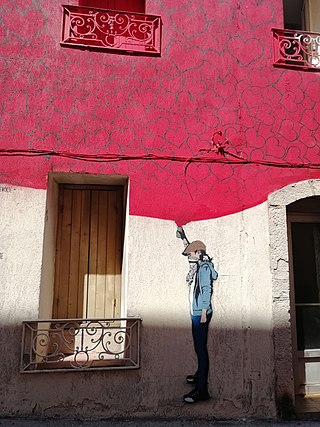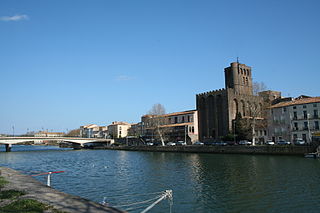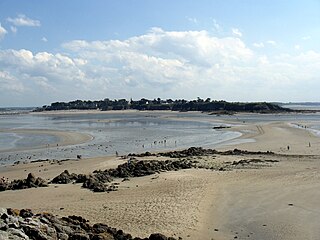
Aude is a department in Southern France, located in the Occitanie region and named after the river Aude. The departmental council also calls it "Cathar Country" after a group of religious dissidents active in the 12th to 14th centuries.

Hérault is a department of the region of Occitania, Southern France. Named after the Hérault River, its prefecture is Montpellier. It had a population of 1,175,623 in 2019.

Cap d'Agde is a seaside resort on France's Mediterranean coast. It is located in the commune of Agde, in the Hérault department within the region of Occitanie. Cap d'Agde was planned by architect Jean Le Couteur as part of one of the largest state-run development schemes for holidays in French history. It is also one of the cities in France where an increasing number of retirees reside since 1980.

Lorient is a town (commune) and seaport in the Morbihan department of Brittany in western France.

Sète, also historically spelled Cette and Sette, is a commune in the Hérault department, in the region of Occitania, southern France. Its inhabitants are called Sétois (male) and Sétoises (female) in French, "Setòris" and "Setòria" in Occitan.

Agde is a commune in the Hérault department in Southern France. It is the Mediterranean port of the Canal du Midi. It is situated on an ancient basalt volcano, hence the name "Black Pearl of the Mediterranée".

Douarnenez, is a commune in the French department of Finistère, region of Brittany, northwestern France.

Frontignan is a commune in the Hérault department in southern France.

Audierne is a commune in the Finistère department of Brittany in northwestern France. On 1 January 2016 the former commune of Esquibien merged into Audierne.

Marseillan is a commune in the Hérault department in southern France. As of 2021, the population of Marseillan is 7643.

The Étang de Thau or Bassin de Thau is the largest of a string of lagoons (étangs) that stretch along the French coast from the Rhône river to the foothills of the Pyrenees and the border to Spain in the Languedoc-Roussillon. Although it has a high salinity, it is considered the third largest lake in France.

Saint-Valery-sur-Somme, commune in the Somme department, is a seaport and resort on the south bank of the River Somme estuary. The town's medieval character and ramparts, its Gothic church and long waterside boardwalk, make it a popular tourist destination.

Yport is a commune in the Seine-Maritime department of France’s Normandy region. The residents are known as Yportais or Yportaises.

Gigean is a commune in the Hérault département in Occitanie in southern France.

Sète Agglopôle Méditerranée is an intercommunal government structure, in the Hérault département of the Occitanie région, in France. Its seat is in Frontignan. Its area is 310.3 km2. Its population was 125,325 in 2018, of which 43,686 in Sète and 22,731 in Frontignan. The Communauté d'agglomération du Bassin de Thau was established in December 2002. The former Communauté de communes du Nord du Bassin de Thau was merged into it in January 2017, and its name was changed to Sète Agglopôle Méditerranée in September 2017.

Saint-Jacut-de-la-Mer is a commune in the Côtes-d'Armor département of Brittany in northwestern France.

Barzan is a commune in the Charente-Maritime department in the Nouvelle-Aquitaine region of south-western France.

Bourcefranc-le-Chapus is a commune in the Charente-Maritime department in the Nouvelle-Aquitaine region in southwestern France. The commune was created in 1908 from part of Marennes. Bourcefranc-le-Chapus is a major oyster farming port. Fort Louvois is a fortification built by Vauban on the Chapus islet in front of the town.

La Tremblade is a commune in the Charente-Maritime department and Nouvelle-Aquitaine region of southwestern France.

Roquebrun is a commune in the Hérault department in the Occitanie region in southern France.




























